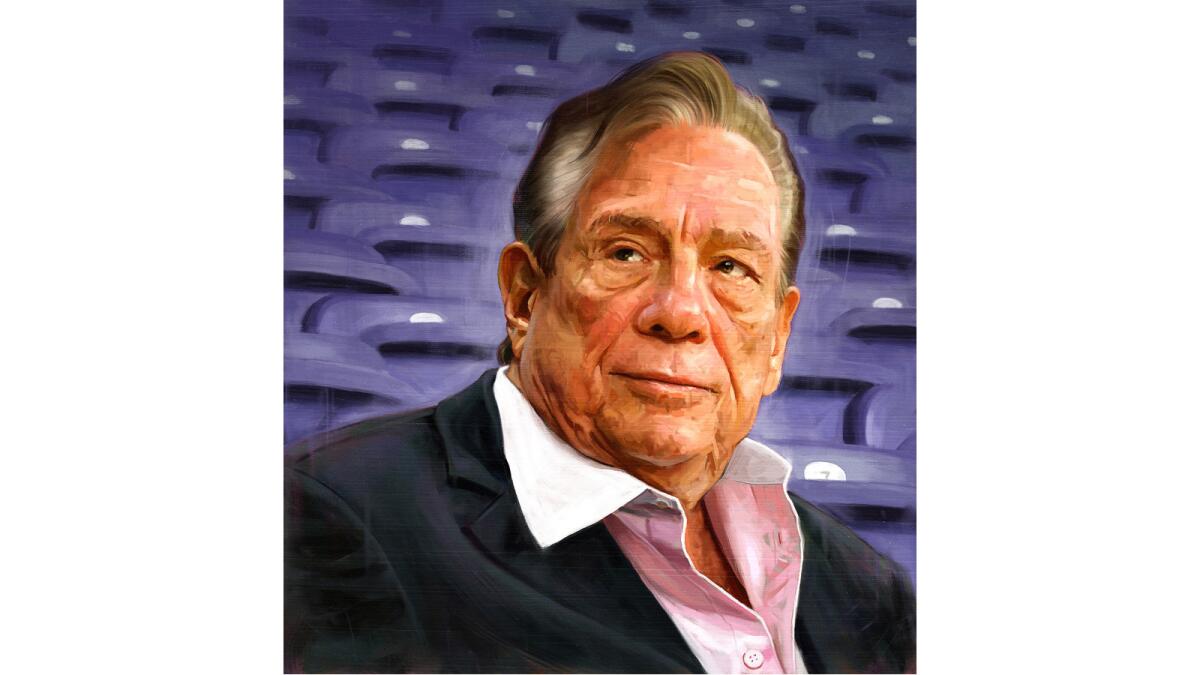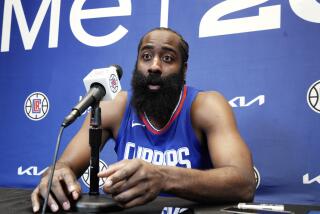Donald Sterling built an empire and an image; words were his undoing

Inside the pillared estate on North Beverly Drive, after a television interview that lasted an hour and 20 minutes, Donald Sterling hoisted himself out of his chair. The Clippers owner and real estate mogul took a few steps before his knees buckled and he stumbled toward the living room floor.
Two people on either side kept the 80-year-old billionaire from falling, witnesses recalled.
It had been a rough day.
When the CNN crew arrived at his home at 10:45 that morning in May, Sterling greeted everyone with a handshake and lighthearted basketball banter. His interview with Anderson Cooper was to last five minutes with a simple mission, a confidant said. Apologize. Beg forgiveness for his recorded remarks about African Americans. Apologize again.
Some Sterling advisors who were supposed to be on hand to supervise his attempt at redemption didn’t show. Two of his acquaintances were there but remained in the background.
Sterling appeared on national television with the top buttons of his dress shirt undone as usual and an ample belly oozing over dark slacks. He cried and expressed remorse, then suddenly launched a scathing attack on former Laker Magic Johnson.
“Well, what kind of a guy goes to every city, has sex with every girl, then he catches HIV…? I think he should be ashamed of himself,” Sterling told Cooper. “But what does he do for the black people? He doesn’t do anything.”
The disgraced owner had never been known as a master of contrition, but his rant at one of the beloved figures in American sports made things even worse.
For decades, Sterling’s business savvy, intermittent charm and charitable contributions had insulated him from the consequences of his eccentric behavior. No longer.
Sterling had worked hard to create his own reality, spending millions on newspaper ads promoting his real estate empire, his charity work and himself — even as his Clippers were perennial losers and he was accused in lawsuits of discriminating against minority tenants whose rent payments helped make him rich.
“I think he has always lived in his own world,” said Bruce McNall, the former L.A. Kings owner and a longtime Sterling friend. “He created a world of his own for whatever reasons, and has lived in that world.”
::
Donald Samuel Tokowitz was born in Chicago in 1934, the son of Russian immigrants. The family moved to California when he was a child.
Raised in Boyle Heights, then a predominantly Jewish neighborhood east of downtown Los Angeles, Sterling was a class president and gymnast at Roosevelt High School. He later married his high school sweetheart, Rochelle “Shelly” Stein.
He began to reinvent himself at 25 when he changed his last name to Sterling. In a court petition in 1959, Donald and Shelly said Tokowitz was difficult to pronounce and that changing it to Sterling would benefit them in business dealings.
Sterling graduated from Southwestern Law School and was admitted to the California bar in 1961. He practiced divorce and personal-injury law and soon began accumulating apartment buildings in Beverly Hills. He and his wife now own more than 150 properties, mostly in Los Angeles County, that are home to about 20,000 tenants.
Sterling, the son of a vegetable peddler, was not shy about trumpeting his transformation. In his penthouse office in Beverly Hills, Sterling often showed visitors a Louis XIV desk, paintings by Rembrandt and Renoir and centuries-old Chinese antiques. He eagerly dropped celebrity names, bragging that he bought properties from Elizabeth Taylor and John Wayne, and once boasted of plans to buy an NFL franchise.
After Sterling bought the San Diego Clippers in 1981, his picture popped up on billboards around town.
“My promise,” said the billboards, emblazoned with the name Donald T. Sterling, “I will make you proud of the Clippers.”
During the Clippers’ season opener in October 1981, he sat courtside, sipping white wine. By the final minutes, Sterling, then 47, had discarded his sport coat and unbuttoned his shirt to the navel. With 11 seconds left in the game, he sprinted across the court and jumped into the arms of a startled Paul Silas, the team’s coach.
The public had its first glimpse of a different sort of sports owner.
A decades-long publicity push dating to at least the 1970s centered on ads in The Times and other newspapers.
Some of the ads made claims that stretched credulity. Sterling as the face of the “No. 1 real estate company for 42 straight years.” Sterling offering the world’s most luxurious apartments for rent.
In recent years, some promoted Sterling’s associations with local luminaries, celebrities and black community leaders. Others juxtaposed generic photos of his apartment buildings with those of attractive young women.
In 1977, a small ad in The Times announced the “Donald T. Sterling Museum.” It stated that millions of dollars would be invested in a property across from the Beverly Hills Hotel and that museum proceeds would benefit a local hospital. The type of museum wasn’t mentioned. The ad, which featured a drawing of a building that resembled Sterling’s current home, ran twice, but the museum never materialized.
With their homemade look, the ads “became kind of a running joke in L.A.,” said Marty Kaplan, professor of entertainment, media and society at USC. “He was turning himself into a brand and there are potentates all over the world who have created false identities for themselves the same way.”
On a website, sarcastically dubbed the Donald T. Sterling Graphic Design Foundation, detractors spent five years savaging the ads, calling them “painful to see.”
Sterling declined to be interviewed for this article.
The benevolent and civic-minded image Sterling sought through his self-promotion was at odds with a man who resorted to bullying tactics to get what he wanted, recalled acquaintances and ex-employees.
“I thought that he did not treat anyone well, regardless of race or background,” Arn Tellem, the longtime sports agent and former Clippers vice president and general counsel, said at a recent forum at Southwestern Law School. “He was just a very tough person who was going to have it his way all the time…”
Tellem wasn’t surprised by Sterling’s predicament.
“There is karma,” he said. “It just takes, sometimes, 33 years.”
::
Not long after Sterling purchased the Clippers, he offered $1,000 to the winner of a free-throw-shooting contest. San Diego attorney Michael Spilger sank nine of 10 shots to win. When he tried to collect the prize, Sterling instead offered a vacation in Puerto Rico, minus airfare.
Spilger demanded the cash, then sued. The owner quickly paid up.
Years later, Spilger ran into Sterling at a Clippers function. The owner hadn’t forgotten, Spilger said, and chastised him for suing.
“What you did was reprehensible,” Spilger recalled Sterling saying.
Some associates cringed at Sterling’s habit of invading their space. Once, he rubbed a sportswriter’s shoulders for several minutes and measured the biceps of a Clippers player, according to people who witnessed the incidents. At games, Sterling sometimes ushered guests into the Clippers’ locker room to gawk at the players as if he were showing off prized possessions. The visits made some players so uncomfortable that they did their best to avoid his entourage.
The caustic, combative side of Sterling has emerged during the many lawsuits in which he’s been involved.
One that resulted in a confidential settlement accused Sterling of punching a Staples Center security guard in the chest before a Clippers game because the guard did not open the door for one of the owner’s guests. In a sworn statement, the security guard claimed Sterling said, “I didn’t hit you. I affectionately touched you.”
Over the years, Sterling acquired a reputation for contentious exchanges with opposing counsel and testimony that sometimes veered into the bizarre.
He once complained under oath about “loose women” in Hollywood, and in a different case offered unprompted, graphic tales of how he paid for sex. Another time, Sterling testified that his middle initial didn’t stand for Tokowitz and that where he attended law school was confidential.
He accused John Denove, the plaintiffs’ attorney in a sexual harassment lawsuit, of making faces during a deposition.
“Are you trying to flirt with me? You just winked at me twice,” Sterling said, according to a transcript. “Why are you winking at me? Are you sexually harassing me?”
A few questions later, the outburst continued: “Do you think I’m interested in you? Do you think I’m gay?”
At one point, Denove said, he noticed Sterling’s lawyer nudging his client in an apparent effort to squelch an answer. Sterling didn’t take the hint.
“He turns to his own attorney and says, ‘Stop kicking me. I told you not to kick me!’” Denove recalled in a recent interview.
“I think he’s used to getting away with this stuff,” Denove said. “And because he has been successful in getting away with it, I think his self-control button is a little slow to reset itself.”
::
Sterling’s recent troubles began in April when his remarks about blacks became public. In a recording made by his companion V. Stiviano and leaked to the TMZ website, Sterling scolded her for posting an Instagram photo of herself with Magic Johnson. Sterling also told her not to associate publicly with blacks or bring them to Clippers games.
Amid the furor that followed, NBA Commissioner Adam Silver banned him for life from the league and pushed for the franchise’s sale to former Microsoft chief executive Steve Ballmer for a record $2 billion.
Sterling met Stiviano, who is of Mexican and black descent, at the 2010 Super Bowl in Miami. She was 27.
He hired her as his personal assistant and she became a fixture at his offices. She was frequently by his side at public events and Clippers games.
Last October, Stiviano, impossible to miss in a flowing green dress with a plunging neckline, celebrated her 31st birthday at Staples Center. Next to Sterling in his usual courtside seats, Stiviano danced and waved and, at one point, reached out to touch players during the preseason game against the Sacramento Kings.
Sterling never hid his infatuation with Stiviano, the personal assistant and caretaker he described as his lover. He stared at her. When they didn’t sit together, he waved. To some in the Clippers organization, the relationship created deep concern.
“People were worried because he was acting so erratically,” said a Clippers employee who would speak about Sterling only if granted anonymity. “He would look across the court at her during games like he was a 12-year-old guy in love with his first crush.”
The antics became such a distraction during the October game, according to another Clippers employee, that Coach Doc Rivers turned to assistant Alvin Gentry.
“This is embarrassing, we can’t have this happening,” Rivers said.
“There’s nothing we can do,” Gentry said. “It’s Donald’s world.”
::
These days, Sterling spends much of his time orchestrating his legal moves from his 5,410-square-foot home. Modest by Beverly Hills standards, it’s fronted by a low hedge on nearly three-quarters of an acre just south of Sunset Boulevard.
He’s been spotted recently with female companions at tony restaurants around the region, including Mr. Chow and The Grill.
Over Father’s Day weekend in mid-June, Sterling and a group of young women stayed at the JW Marriott Desert Springs Resort and Spa in Palm Desert. In photos splashed across social media, the owner seemed like a man without a care.
A guest snapped a selfie with the shirtless Sterling as he snoozed in a chair by a pool.
Sterling has remained hands-on with his real estate portfolio. Since January, he has scooped up at least six properties for $14.9 million.
Give him the cross streets of a Beverly Hills property, said his attorney Bobby Samini, and Sterling knows the market so well that he can instantly assess the value.
He closed in May on a $5.16-million Spanish-style single-family home in Beverly Hills that will be rented out.
“He was always lovely, always appropriate,” said Michael Libow, the real estate agent who brokered that sale and worked with Sterling on other deals. “He’s incredibly sharp and has great retention of detail.”
Sterling has kept virtually all of the real estate he’s bought since the 1960s. For decades, his company has been the lone occupant of the seven-story Art Deco landmark at the corner of Beverly Drive and Wilshire Boulevard in Beverly Hills. He occupied the top two floors; the other five remained empty.
Michael Selsman, a friend since 1962, recalled taking a proposal to Sterling. “Barney’s is offering $15 million,” Selsman remembered saying of the department store’s bid to buy the building. “And he said, ‘What would I do with another $15 million?.... Too much trouble. Tell them to forget it.’”
Selsman said that was Sterling’s standard response: “He was famous for saying, ‘I buy. I never sell.’”
Sterling’s real estate acumen contrasts with reports by two doctors retained by Shelly Sterling in May. They claimed her husband is no longer competent to manage his business affairs, that he couldn’t draw a clock or spell “world” backward and is in the early stages of Alzheimer’s disease.
That precipitated his removal as a trustee for the Sterling Family Trust, which owns the Clippers, and allowed his wife’s rushed agreement to sell the team to Ballmer.
On a conference call in early June, Sterling threatened to “take out” his wife’s lawyer, Pierce O’Donnell. Hours later, Sterling left profane, threatening messages for the doctors who deemed him unfit.
“This is a conspiracy,” Sterling told Dr. J. Edward Spar in a voice sputtering with anger. “You and the lawyer got together to try to establish that I was unable to perform. I’m more able to perform than you are.
“I’m just so excited. I’m so angry. I just can’t believe it.”
He closed with: “Thank you very much, doctor.”
On Monday, a judge cleared the way for Shelly Sterling to sell the team to Ballmer. Sterling isn’t giving up, pursuing lawsuits against the NBA and his wife.
::
If the image Sterling had worked so hard to create was damaged by Stiviano’s recording, it was all but wrecked by his words in his failed try to redeem himself on CNN.
After his May interview with Anderson Cooper, a subdued Sterling retreated to his bedroom. Propped in a chair in front of his bed, Sterling put on slippers and stared at the Clippers-Oklahoma City Thunder playoff game on his big-screen television, struggling to stay awake. The CNN crew filmed him watching the afternoon contest.
Sterling asked them how the interview had gone. He wondered if he had made the right impression.
Times staff writer Broderick Turner contributed to this article.
More to Read
Start your day right
Sign up for Essential California for news, features and recommendations from the L.A. Times and beyond in your inbox six days a week.
You may occasionally receive promotional content from the Los Angeles Times.







